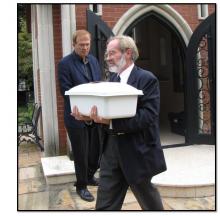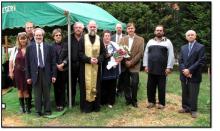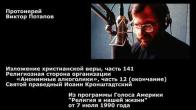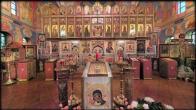Our Parish
You are here
09.11.09. Burial of the remains of victims of the "Red Terror"
 Seventy-eight years ago, in October 1931 the Soviet Union launched its first "great construction project of the century" – the building of White Sea-Baltic Canal (Belomorkanal). Construction was done cheaply and quickly. Already in April 1933, Stalin and his henchmen were enjoying a festive cruise along the new waterway.
Seventy-eight years ago, in October 1931 the Soviet Union launched its first "great construction project of the century" – the building of White Sea-Baltic Canal (Belomorkanal). Construction was done cheaply and quickly. Already in April 1933, Stalin and his henchmen were enjoying a festive cruise along the new waterway.
Record time and the low cost of this ambitious project were paid at the cost of immense suffering and blood - According to various sources as a result of overwork, abuse, hunger and cold anywhere from 100 to 200 thousand people - prisoners of the Gulag - perished.
This is a well-known story, although in present-day Russia, more and more people are trying to deny or justify it. The Communist Party was never brought to justice and because of this the ghost of Communism continues to torment the country to this day. In the center of its capital stands the mausoleum with the corpse of the originator of this terror against mankind. The corpses of other villains, including Stalin, are also buried in the center of Russia, along the Kremlin wall.
At the same time countless tortured, murdered innocent victims are spread all over the country in unmarked graves…
There once lived a wonderful man by the name of Michael Yanovich Makarenko. He was born in the year of the start of the construction of Belomorkanal. He was an orphan, was “adopted” by Russian soldiers and eventually became a political prisoner. In 1977, after serving an eight-year term in the Gulag, he was sent into 5 years of exile, from which he fled. He was put on the most-wanted list and at the same time organized the removal of a small number of remains of deceased prisoners from the Belomorkanal district. In a private apartment Moscow Makarenko held a symbolic funeral for all the victims of terror. Separate funeral rites were conducted by Orthodox priests, Jewish and Muslim clerics. Using the fact that in the Alexander Garden at the Kremlin in Moscow was undergoing renovation, Michael Yanovich buried a portion of the remains under the Kremlin wall. This happened in 1978 and the event was captured on tape (now on VHS).
Another part of the remains of Michael Makarenko was able to smuggle to the West when he was expelled by the authorities.
 Michael devoted the rest of his life to the establishment of the Victims of Communism Memorial in the capital of the United States. He wanted to bury the remains of the victims of terror at the Memorial site. Unfortunately, Michael Makarenko didn’t live long enough to realize his dream. Dmitry Goldgaber, a longtime friend of Mikhail Makarenko purchased a site at Rock Creek Cemetery to bury the remains at a site next to the grave of Mikhail Makarenko.On the morning of September 9, 2009 it rained in Washington, but by midday the clouds disappeared and the blue sky shone a warm autumn sun.That day at St. John the Baptist Cathedral a short memorial service was served for the victims of communist terror. The service was conducted by Fr. Victor Potapov. He did not mention names in the funeral prayers, because the names are known only to God. The people present were few, although the church seemed crowded. Maybe it was just my imagination, but it seemed that the souls of the tortured and unburied were present with us during the service. Along with the flames of the candles our prayers rose to the Lord for the repose of those who perished in countless sufferings in the GULAG of our poor Russia.After the requiem remains of the martyrs were taken to the cemetery. Gregory Burnside, Grisha, faithful companion and assistant to Michael Makarenko, without whom today's event could not have taken place, carried the small children-size coffin with the remains into the Orthodox Iveron Icon chapel, where Fr. Victor again read a memorial prayer.
Michael devoted the rest of his life to the establishment of the Victims of Communism Memorial in the capital of the United States. He wanted to bury the remains of the victims of terror at the Memorial site. Unfortunately, Michael Makarenko didn’t live long enough to realize his dream. Dmitry Goldgaber, a longtime friend of Mikhail Makarenko purchased a site at Rock Creek Cemetery to bury the remains at a site next to the grave of Mikhail Makarenko.On the morning of September 9, 2009 it rained in Washington, but by midday the clouds disappeared and the blue sky shone a warm autumn sun.That day at St. John the Baptist Cathedral a short memorial service was served for the victims of communist terror. The service was conducted by Fr. Victor Potapov. He did not mention names in the funeral prayers, because the names are known only to God. The people present were few, although the church seemed crowded. Maybe it was just my imagination, but it seemed that the souls of the tortured and unburied were present with us during the service. Along with the flames of the candles our prayers rose to the Lord for the repose of those who perished in countless sufferings in the GULAG of our poor Russia.After the requiem remains of the martyrs were taken to the cemetery. Gregory Burnside, Grisha, faithful companion and assistant to Michael Makarenko, without whom today's event could not have taken place, carried the small children-size coffin with the remains into the Orthodox Iveron Icon chapel, where Fr. Victor again read a memorial prayer.
... Under the bright blue sky, we took turns throwing handfuls of bright orange-red earth on small small, almost toy coffin. There in the ground lay the remains of martyrs, crushed by historical injustice….
The coffin containing the remains of the martyred was covered with irregular patterns of orange-red earth. The cemetery workers asked us to move away and started pouring earth into the grave from the back of a small truck. We withdrew and waited to put flowers on the grave. One woman I met for the first time came because her grandfather was one of the prisoners of Belomorkanal. She brought a bouquet of luxurious red roses. Michael Yanovich Makarenko’s daughter Lisa and her husband, who arrived from Russia, also brought flowers for Michael Yanovich and for the victims of Communism to whom he dedicated his life.
I thought about the millions murdered and one of my uncles, Alexander P. Witte. He also was a prisoner on the White Sea Canal, but survived. Maybe he knew or met someone whose remains we now buried. He survived the White Sea Canal, but, like millions of others, was arrested again. The Memorial Society in Russia discovered that this occurred on October 23, 1937, and on January 31, 1938 he was executed on charges of "espionage". He is buried in an unmarked grave somewhere in the Perm region. O, how many such unmarked and unknown graves there are in the vast expanses of Russia! But now in Washington there is a grave awaiting its marker which we shall make a reality with a memorial for all to cherish in the memory of these heroes, these innocents.
Here one can come and remember these sufferers, who they were and what they might have become. And as I did on this day, I realized how miniscule are our everyday "problems" in comparison with the grief experienced by millions of those who suffered at the hands of the godless authorities.
May Christ, our immortal King and our God, give them rest and make their memory eternal.
Vera Genisaretskaya
Media Office of the Eastern American Diocese
PARISH LIFE
RECENT VIDEOS
Address of our Cathedral
Subscribe to our mailing list
While all the materials on this site are copyrighted, you may use them freely as long as you treat them
with respect and provide attribution on the Russian Orthodox Cathedral of St.John the Baptist of Washington DC.










